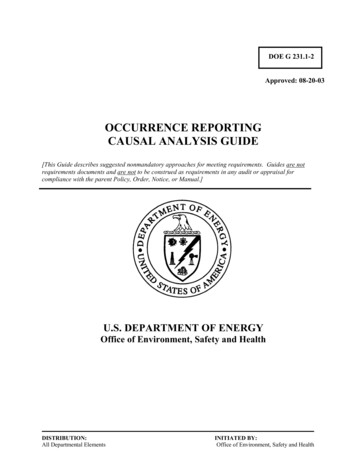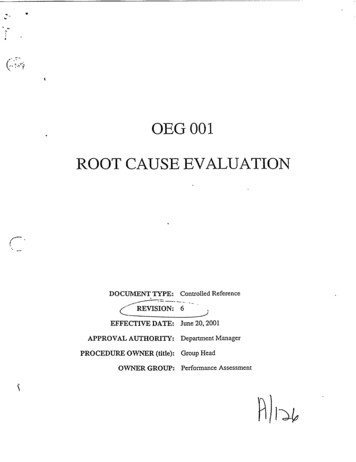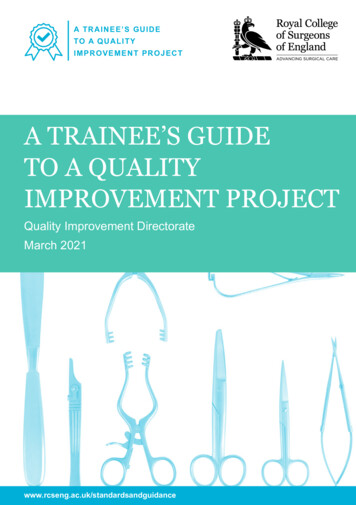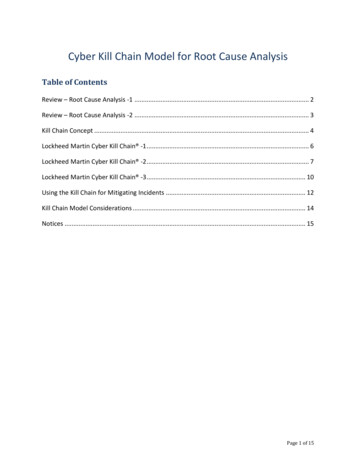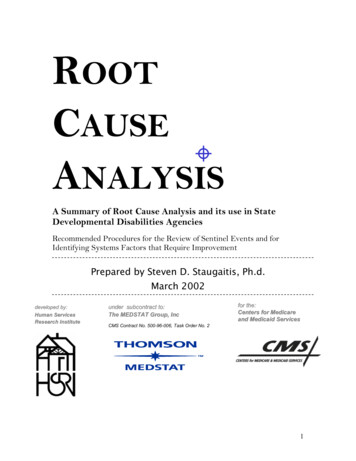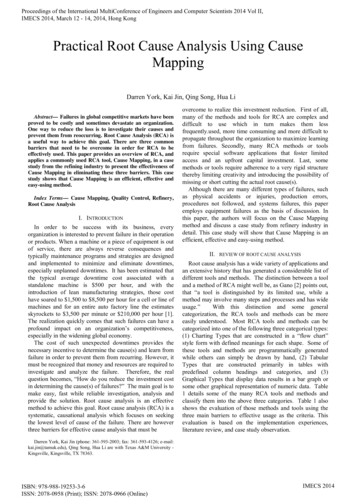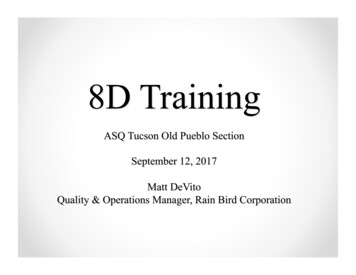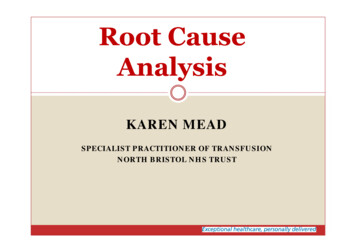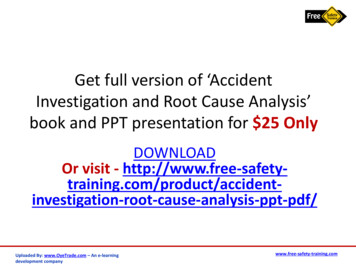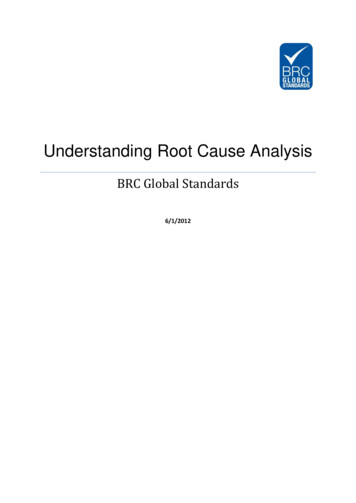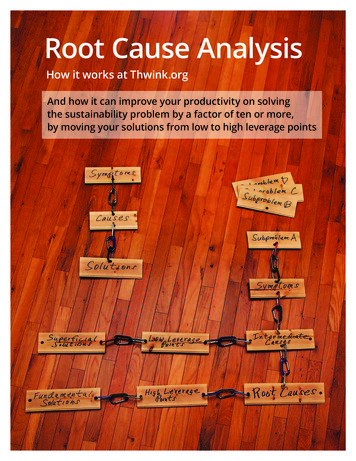
Transcription
Root Cause AnalysisHow it works at Thwink.orgAnd how it can improve your productivity on solvingthe sustainability problem by a factor of ten or more,by moving your solutions from low to high leverage points
Environmentalists Are Making a Difference.But it’s not enough of a difference to solve the problem.The evidence is irrefutable. Despite over forty years of prodigiousand often brilliant effort, problem solvers have failed to solve thesustainability problem. The footprint continues its relentless rise,as if we’ve done almost nothing.Selected Footprints 2007In Percent of BiocapacityBolivia14%Latin America47%It’s not because it’s a hard problem.Canada47%Russia77%It’s not because it just takes a long time to solve.Africa93%World150%Europe162%India180%WHY are solutions not working?It’s because popular solutionsdo not resolve root causes.The Ecological Footprint is a measure of human demand on the Earth’s ecosystems. It is astandardized measure of demand for natural capital (the green line) compared to the planet’secological capacity to regenerate (the black one planet line). When demand exceeds capacitya system is said to be unsustainable and in overshoot. Demand divided by capacity equalspercent biocapacity in use, as listed in the table for selected regions. In 2007 the world’sfootprint reached 150% of biocapacity, which is 50% overshoot.2Mexico200%United States205%China220%Asia225%United Kingdom377%Saudi Arabia638%Japan783%Israel1600%Data source: hodology, the 2010 data tables.
Forty Years of Common Sense SolutionsModern environmentalism burstinto the public sphere in 1962, whenRachel Carson’s Silent Spring launchedthe movement.Agenda 21Better TechnologyBiomimicryBuilding on earlier sentiments expressed by activists likeHenry David Thoreau, John Muir, and Aldo Leopold, Silent Spring led to action. Acts regulating chemicals andpollution were passed. In the 1970s the environmentalmovement picked up speed. Earth Day happened. Nationscreated environmental protection agencies. The UNEP wasfounded. Thousands of NGOs began to make a difference.A string of international summits put protecting the environment in the spotlight. The tide seemingly began to turn,as problems like acid rain and local pollution were reduced.One international problem, stratospheric ozone depletion,was solved.Cap and TradeCollective ManagementConservation ParksCorporate Social ResponsibilityCradle to Cradle DesignDemonstrations and MarchesTremendous gains have been made. But it’s notenough. Popular solutions like those listed help some butare not enough to cure the patient, because they put the cartbefore the horse.Education on the Three RsEnergy OffsetsGrassroots ActivismGreen BuildingGreen RevolutionInternational SummitsInternational TreatiesNatural Step FrameworkOrganic FarmingPermacultureBefore we can design solutions we must first diagnose the patient. WHY is he or she sick? In other words,WHY is the human system unsustainable? What’s the rootcause of this pattern of behavior?Pollution TaxesPopulation ControlYou would never dream of going to a doctor who jumped toconclusions about how to treat your illness without first diagnosing its cause. The sustainability problem is no different.Prescriptive RegulationsThis line of attack, find the root causes first and design solutions second, is what distinguishes the work at Thwink.org. Itcan lead to an entirely new class of solutions that have neverbeen tried.Renewable EnergySustainable DevelopmentSo how can we find the root causes?3
There’s only one known way to find root causes:Root Cause Analysis.Motorola has adefect rate of .0015%.HistoryRoot Cause Analysis lies at the heart of modernquality management. As managers delved everdeeper into the causes of their quality problems,they converged on a discovery that explainedeverything: all problems arise from theirroot causes. Find the root causes, resolve thempermanently, and your problem is solved.made it the core of his own techniques. Thenhe went even further by creating his famousFourteen Points. To his disappointment UScompanies were not interested. So he took hiswork to those who would listen. Ironically thiswas post World War Two Japan. There his ideasflourished.The invention of Root Cause Analysis is credited to Sakichi Toyoda (1867 - 1930), the “Kingof Japanese Inventors,” the “Japanese ThomasEdison,” and the founder of Toyota. Toyodacalled the method “The Five Whys.” This asksWHY five times or until the root cause(s) of aproblem is found.When Japan began to trounce the rest of the industrialized world in the 1970s, US managersfinally saw the light and asked Deming for help.Further events saw Root Cause Analysis andquality control evolve into codified practiceslike Six Sigma, developed by Motorola beginning in 1986. This allowed Motorola to reducedefect rates to an amazing .0015%, which gavethem a tremendous competitive edge. 1The quality revolution, really the root causerevolution, began in Japan over a hundred yearsago. And there it would have stayed, if not forthe consulting work of W. Edwards Deming.He studied what they were doDefinitions ing, realized its importance, andA root cause is the deepest cause in a causal chainthat can be resolved. If the deepest cause cannot beresolved, it’s not a real problem. It’s the way things are.PrinciplesRoot cause analysis is “a class of problem solvingmethods aimed at identifying the root causes of problems or events. . The practice of root cause analysis ispredicated on the belief that problems are best solvedby attempting to correct or eliminate root causes, asopposed to merely addressing the immediately obvious symptoms.” (Wikipedia October 24, 2011)For the class of problems we are concerned with,the core principles of Root Cause Analysis are:1. All problems arise from their root causes.2. A high quality solution is one engineered toresolve a specific correct root cause.3. Only high quality solutions can solve difficultproblems.A defect is something that displeases the customer,such as a problem with a cup of coffee at Starbucks.Defects are produced by production processes. Thedefect rate of a process is the average number of defects produced per opportunity to please the customer.4. Only a formally defined process undergoingcontinuous process improvement can produce highquality solutions consistently, economically, and ina short amount of time.1. Source: Achieving Total Customer Satisfaction Through Six Sigma,by Jane Erwin, in Quality Digest, July 1998, www.qualitydigest.com/july98/html/sixsigma.html. Motorola’s 5.7 sigma has beenconverted to a .0015% defect rate using the Process SigmaCalculator at www.isixsigma.com/process-sigma-calculator.2. Source: The Toyota Way, by Jeffrey Liker, 2004. This principle isso critical that book section two is titled “The Right Process WillProduce the Right Results.”Motorola’s success with Six Sigma caused industry giants like General Electric to adopt themethod. In 1999 Root Cause Analysis beganto be applied to the health care industry. Today most major industries employ Root CauseAnalysis in some fundamental way.5. Don’t focus on solutions. Focus on the process.“The right process will produce the right results.” 2These principles are the single mostimportant thing in this booklet.4
Results in Terms of DefectsHere are two examples:“When a Japanese firm took over a Motorola factory thatmanufactured Quasar television sets in the US in the 1970s,they promptly set about making drastic changes in the waythe factory operated. Under Japanese management [usingtheir form of Root Cause Analysis and defect prevention],the factory was soon producing TV sets with 1/20thas many defects as they had produced under Motorola’smanagement. They did this using the same workforce,technology, and designs, and did it while lowering costs,making it clear that the problem was Motorola’s management.” (The Six Sigma Handbook, 2003, page 4)After Toyota took over management of a General Motorsfactory, introduced their approach to quality management,and retrained the workforce, these were the results:“Full production began in 1985, and by year end 1986, [theplant] had the highest quality and productivity of any GMplant. Quality defects dropped from 12 to 1 per vehicle. Cars were assembled in half the time. Absenteeismdropped to 3% [from 20%]. Worker satisfaction and engagement soared. Operational innovation was on the rise,with employee participation over 90% and nearly 10,000ideas implemented. Same people, same union, same equipment. Radically different outcome. All in under two years.”(The Elegant Solution: Toyota’s Formula for Mastering Innovation, 2007, page 65)These examples show it’s the process you use that makesall the difference. The more mature the process, the fewerthe defects. The right process can take hold surprisinglyfast. No process is a panacea, but the right process underthe right management can work miracles.Modern environmentalismhas a defect rate of 91%.Where We Are TodayEnvironmentalists find problems and solve them. Eachunsolved problem is a defect produced by the problemsolving process. The customer is humanity.The defect rate of the process environmentalists are currently using is easily determined by the table. This liststhe top eleven environmental problems as determined bythe SCOPE study, published in the United Nations Environmental Program’s Global Environmental Outlook2000, page 339.Only one problem is solved. This gives a defect rate of10 out of 11, which is 91%. It needs to be near zero sothat all 11 problems are solved.Environmentalism will not become modern environmentalism until it takes up Root Cause Analysis, ideallywith the same passion Motorola took it up with. Motorola was so enthused at its potential that they developedtheir own wrapper process for Root Cause Analysis.This was Six Sigma. The wrapper allowed the businessworld to immediately swallow Root Cause Analysishook, line, and sinker.5Environmental ProblemSolved1. Climate changeNo2. Freshwater scarcityNo3. Deforestation and desertificationNo4. Freshwater pollutionNo5. Loss of biodiversityNo6. Air pollutionNo7. Soil deteriorationNo8. Ecosystem functioningNo9. Chemical pollutionNo10. Stratospheric ozone depletionYes11. Natural resource depletionNoLet’s see if we can do the same for environmentalism.This begins with understanding exactly why today’sproblem solving approaches are not working.
Conventional Approaches to Solving theSustainability Problem Are Not Workingbecause without a map all problem solvers can see is the superficial layer.this point and you can see exactly why popular solutions don’twork, no matter how well promoted or managed, and no matterhow many clever and “better” variations are tried.Despite its best efforts for over forty years, environmentalismremains unable to solve the sustainability problem. The map explains why. It’s because popular solutions operate only on thesuperficial layer. Without a map that’s all problem solvers cansee. This causes them to unknowingly fall into the SuperficialSolutions Trap (explained on the map), which leads to commonsense solutions like those listed on page 3. These should workbut they don’t. Why is this?For example, one popular solution is consumer education on theThree Rs of reduce, reuse, and recycle. It’s been promoted fordecades by thousands of NGOs, magazines, movies like An Inconvenient Truth, etc, in countless “better” variations. But thishasn’t worked. WHY? Because consumers are bombarded withfar more messages to buy more stuff, bigger stuff, better stuff,and so on, in keeping with the modern fallacy of “He who dieswith the most toys wins.” This stronger message completelyoverwhelms the relatively puny message of the Three Rs. Theresult is massive overconsumption and solution failure.The most fundamental law in all of science is the Law of Causeand Effect: every effect has a cause. From that follows the Lawof Root Causes: all problems arise from their root causes.This is the fundamental principle of Root Cause Analysis.All problems arise from their root causes. If attempted solutionshave failed to solve a problem for generations, then the only possible reason is the solutions have been incapable of resolving theroot causes. No other explanation is possible.Another example of a superficial (aka symptomatic) solution iscorporate social responsibility (CSR). It too has been heavilypromoted. The idea is that corporate managers can be convincedthey have the moral responsibility to help solve the sustainability problem and that doing so will benefit them as well as otherstakeholders. But this too hasn’t worked. The CSR message is aweak force compared to the much stronger root cause force ofthe corporate goal of maximization of short term profits. Untilthis goal is changed, large for-profit corporations will continue tobehave unsustainably because that’s what they’re programmedto do. As Upton Sinclair explained in 1935, “It is difficult to geta man to understand something, when his salary depends uponhis not understanding it!”The key to grasping how Root Cause Analysis works at Thwink.org lies in understanding the causal chain behind all difficultproblems. Here is the key insight:Superficial solutions fail on difficult problemsbecause they cannot exert a greater force onintermediate causes than root causes can.That’s why the vertical arrow running from root causes to intermediate causes is huge compared to the small horizontal arrowrunning from low leverage points to intermediate causes. Grasp6
Environmentalism Can Move Its Solutionsto the Fundamental Layerthe same way the business world did: by developing a wrapper for Root Cause Analysis.If it works on business problems it will work on the sustainability problem.A wrapper packages something tomake it more transportable, cohesive,and useful. Root Cause Analysis in itsraw form is only a small set of principles. To be applied it needs a wrapper. The business world has designeda number of wrappers for Root CauseAnalysis like Six Sigma, Lean SixSigma, Total Quality Management,Kaizen, and the ISO 9000 family ofstandards.Without the right wrapper a process cannot be easily applied.While Root Cause Analysis was invented over a hundred years ago, itwas not until 1986 that an easy-to-usewrapper with wide applicability wasdeveloped. This was Six Sigma. It’sbecome so popular that “82 of the 100largest companies in the US have embraced it.” (Business Week, June 10,2007, Six Sigma: So Yesterday?)Root Cause Analysis has never beenseriously applied to large-scale socialsystem problems because no wrapperexists for problems of this class. To fillthis gap Thwink.org has developedthe System Improvement Process.Once problem solvers begin using anapproach like this and perfect it theywill enjoy the same results industryhas long achieved, because all problems arise from their root causes.If you’re not working on root causes then you’re not working scientifically.7
Divide and ConquervDesigning a wrapper for Root Cause Analysis in order tosolve the sustainability problem begins with this observation:Modern environmentalism is trying to solve four major subproblems simultaneously without realizing it—an impossibletask. It’s like the Wright brothers trying to solve the problemof manned flight without dividing it into many little problems.They didn’t fall into that trap. Instead, from 1899 to 1903 theyidentified and solved these formidable subproblems:Causes1. How to achieve flight control via wing warping.EquipmentProcessEffectPeople2. How to design an airfoil with a high lift to drag ratio.3. How to test aircraft models without the expense andtime of flying full size models. (They built their ownwind tunnel and used miniature wing models.)ProblemSecondaryCausePrimaryCause4. How to design a propeller with high efficiency.MaterialsEnvironmentManagement5. How to build a lightweight high horsepower motor.Orville and Wilbur Wright were so good at methodical decomposition that they solved every one of these little problems. When all were solved so was the one big problem.It was solved so well that on December 17, 1903 the brothersmade four successful flights into a 27 mile per hour headwind. The final flight traveled 852 feet in 59 seconds.Another example of methodical decompositioninto subproblems is the Ishikawa (fishbone) diagram. The “primary cause” is the root cause.Note the six standard subproblems. Ishikawadiagrams have such broad applicability theyhave become one of the seven basic tools ofquality control.The right decomposition is anancient strategy we know asDivide and Conquer.8
The System Improvement Process is generic. It first decomposes the one bigproblem to solve into the three subproblems present in all difficult large-scale social problems. These subproblems may in turn need further division. Once decomposition is complete,Root Cause Analysis is performed on each subproblem.This works because it allows all the main root causes to be identified and resolved. In onestroke this can change a difficult problem from insolvable to solvable.It’s the same strategy the Wright brothers used. They were trying to fly a plane. We’re tryingto fly a planet.SubproblemSubproblemSubproblemHow to OvercomeChange ResistanceHow to AchieveProper CouplingHow to Avoid ExcessiveSolution Model DriftChange resistance is the tendency forsomething to resist change even when asurprisingly large amount of force is applied. Change resistance is present in allproblems that have defied long attempts tosolve them. Otherwise the problem wouldalready be solved. Resistance may comefrom individual social agents, a group (anorganization), or the system as a whole. Thelast is by far the strongest and is known assystemic change resistance.Proper coupling occurs when the behavior ofone system affects the behavior of one or moreother systems in a desirable manner, using theappropriate feedback loops, so the systemswork together in harmony in accordance withdesign objectives. For example if you never gothungry you would starve to death. You wouldbe improperly coupled to the world around you.A solution model is what a social agent, such as anation, uses to solve its problems. Solution modeldrift occurs when a problem and solution evolveaway from each other. If the gap grows too largethe solution can no longer solve the problem andexcessive solution model drift has occurred.This is normally seen as the only problem tosolve because it is the symptoms of this subproblem that attract initial attention.Social systems are always evolving, so their problems and solutions are always changing and tendto drift away from each other. Solutions must bedesigned to be self-managing so they can evolvewith the problem they are solving.Above are the standard three subproblems. How they apply to the sustainability problem is discussed below:The global environmental sustainability problem has resisted all attempts to solve it for over fortyyears. That effort started on a globalbasis around 1970, when Earth Dayattracted over 20 million participants.A stunning example of change resistance occurred in 1999 when theUS Senate voted a shocking 95 tozero against ratifying the Kyoto Protocol. Not a single senator could bepersuaded to support the treaty, despite the fact that Al Gore was vicepresident at the time.Overcoming change resistance isthe crux of the sustainability problem and must be solved first. Onceresistance is overcome the systemwill “want” to solve the problem justas much as it doesn’t want to solveit now.Analysis discovered that the sustainability problem containstwo proper coupling subproblems:The first is the economic propercoupling subproblem. The economic system is improperly coupled to the greater system it liveswithin: the environment. If it wasproperly coupled there would beno sustainability problem.This subproblem is universallyseen as the only problem tosolve, so that’s what popular solutions focus on. But they haven’tworked. WHY? Because the onebig problem of sustainability ismade up of more than just economic proper coupling. It alsocontains the change resistance,life form proper coupling, and excessive model drift subproblems.Analysis shows these three subproblem are causing this one.The second is the life formproper coupling subproblem.The top two life forms in thehuman system, Corporatis profitis and Homo sapiens, are improperly coupled. The symptom of this subproblem is thatlarge for-profit corporationsare destructively dominatingpolitical decisionmaking.In social systems the goal ofthe dominant social agent determines the goal of the system. Today Corporatis profitis isdominant. Its goal is short termprofit maximization. The endresult is the goal of the humansystem has become short termoriented, which prevents solution of long term problems.An example of excessive modeldrift was the Great Recessionof 2008. What drifted was business regulation. So much laxregulation and deregulationoccurred that huge amounts ofunsustainable debt accumulated. When the bubble poppedthe recession begin, first inthe US and later in Europe andelsewhere.In the sustainability problemit’s the world’s overall abilityto govern itself effectively thathas drifted. As explained onpage 14, modern democracyis broken. It’s no longer ableto solve its biggest problem:global environmental sustainability.This gives us four subproblems. Like the Wright brothers, the right decomposition has changed the game completely.Because we have four small tightly focused subproblems, they are orders of magnitude easier to solve. How the foursubproblems were analyzed is shown on the next six pages, beginning with how the overall problem solving process works.9
How Do We Operationalize Sustainability?By wrapping Root Cause Analysis in a process that fits the problemand using the process to drive everything we do.The four main steps of SIPThe five substeps of system analysisThe three subproblems of the main problemDevelopthe Process1. Problem DefinitionThe System Improvement Process (SIP)SubproblemsChange ResistanceProper CouplingModel Drift2. AnalysisASpend about 80%of your time here.The problemsolving battle iswon or lost in thisstep, so take thetime to get theanalysis right.BFind the immediate cause of the problem symptoms in terms ofthe system’s dominant feedback loops.Find the intermediate causes, low leverage points,and superficial (symptomatic) solutions.CFind the root causes of why the loops in A are dominant.DFind the feedback loops that should be dominant to resolvethe root causes.EFind the high leverage points to make those loops go dominant.Apply theProcess3. Solution Convergence4. ImplementationContinuous Process Improvement – The foundation of the entire processSIP is a “fill in the blanks” framework that let’s you separate the signal from the noise. The well formulated problemto solve is how to fill in the matrix cells. The basic SIP matrixcontains 22 empty cells: 7 for each subproblem plus 1 for overallproblem definition. This plus continuous process improvementgives a total of 23 steps, which is about the minimum for thisclass of problems. The process is generic. SIP was designed fromscratch to solve any difficult large-scale social system problem.The process is flexible. Columns, main steps, and substeps canbe added or changed as needed. SIP implements the core principles of Root Cause Analysis as listed on page 4.they’re based on informed knowledge of how the system willrespond to solution policies. Compare that to today. Problemssolvers basically don’t know how the system will react to a newsolution, so they are forced to resort to a long series of trial anderror. This is taking too long to solve the sustainability problem.The five substeps model the causal structure of each subproblemusing feedback loops. This is crucial because:“Positive feedback loops are the most powerful forces inthe universe.” (John Sterman, Business Dynamics, 2000, p268)In dynamic systems like seven billion people living on a single fragile planet, the driving forces are the system’s dominantfeedback loops at the fundamental level of the problem. Findingthose loops requires building models of the relevant structure ofthe system. Not large complex models, but ones just big enoughto capture the essential structure of the dominant feedback loops.This results in models that are understandable to most everyone.The purpose of SIP is to help you ask the right scientificquestions so you can produce high quality solutions, asdefined on page 4. Solution hypotheses follow this format: “Solution element F pushes on high leverage point G to resolve rootcause H in model I in order to eliminate symptoms J in subproblem K.” Solution hypotheses are generated and tested in SolutionConvergence, followed by Implementation.Structure refers to the feedback loop paths that form the “shape”of a system and reveal how it works. Once you can see that structure you have the same power Galileo had after he built his owntelescopes. Suddenly he could see the structure of the universe,like the four moons of Jupiter and the phases of Venus. His discoveries proved the Copernican system was correct. Yours willhelp see the true structure of the sustainability problem, whichwill allow solution at last!There’s an even greater benefit: Use of a formal comprehensiveprocess like SIP allows you to continuously improve the processuntil it’s good enough to solve your problem.The five substeps of analysis are the heart of SIP. Each subproblem is analyzed to find its root causes and high leveragepoints. After analysis, steps 3 and 4 are relatively easy becauseThese two pages present an overview of the process research program at Thwink.org. Results are met to serve as anexample of what’s possible with a method like SIP and should not be interpreted as the process, the analysis, or the solution.10
Process development and execution ranfrom 2003 to 2009. Process results, theprocess that produced them, and 12 sample solution elements have been writtenup in a book at Thwink.org. See CommonProperty Rights: A Process Driven Approach to Solving the Complete Sustainability Problem.Process ResultsSummary of Analysis for Executing the System Improvement Processon the Global Environmental Sustainability Problem1. ProblemDefini onB.How to AchieveLife FormProper CouplingC.How to AvoidExcessive Solu onModel Dri!SubproblemsymptomsLarge for-profitSuccessful opcorpora!onsposi!on to passingare destruc!velyproposed laws fordomina!ng poli!calsolving the problemdecision makingImproperlycoupledsystemsNot applicableAnalysismodelBasic Dueling LoopsComplete Dueling Loops model. This addsof the Poli!calthe Alignment Growth e andhuman life formsThe Race to the Bo#omamong Poli!ciansThe universal falIntermediate lacious paradigm,causesprimarily GrowthIs GoodD.How to AchieveEconomicProper CouplingNot applicableIntelligent Adapta!on loop in evolu!onary algorithmmodelEconomic and environmental systemsThe World’s PropertyManagement SystemGrowth of IndustrialTechnology and Limitsto Growth (the IPATequa!on factors)Pressure fromLaws giving corporacorporate proxiesExternalized costs of!ons advantagesfor business friendlyenvironmental impactover peoplelegisla!onLogical and emoMore of the truth:Low leverage!onal appeals andiden!fy it, promotepointsbargaining withit, magnify itcorpora!onsTrying to directlyreverse laws thatfavor corpora!onsInternalize costsUse of the media,campaigns,lobbying to get oldlaws repealedMain solu!ons atsystem level: commandand control regula!onsand market-basedmechanisms, like pollu!on taxes and tradablepermits. At agent levelmain solu!ons are 3 Rsand collec!ve mgt.Technical research,environmentalmagazines andar!cles, awarenesscampaigns, sit-ins,marches, lawsuits,lobbying, etc.Corporate social responsibility appeals,green investmentfunds, NGO/corporate alliances, etc.C. Root cause ofwhy loops in Aare dominantHigh poli!caldecep!oneffec!venessMutually exclusivegoals between topLow quality oftwo social life forms,poli!cal decisionsCorpora s profi s &Homo sapiensD. Names offeedback loopsthat should bedominant to resolve root causeYou Can’t Fool Allof the People All ofthe TimeE. High leveragepoint to makeloops in D godominantGeneral ability todetect poli!cal decep!on. This needsto be raised fromlow to high.Correctness of goalsfor ar!ficial lifeforms. The goal ofcorpora!ons needsto be changed.Maturity of thepoli!cal decisionmaking process.This needs to risefrom low to high.Allow firms to easilyincorporate in order tolower transac!on costsfor managing commonproperty sustainably3. Solu onConvergenceNine solu!onelementsCorpora!on 2.0,Corpora s publicusPoli!cian DecisionRa!ngsCommon PropertyRights4. Implementa onNot yet ready for implementa!on because process execu!on is incomplete.Superficialsolu!onsThis booklet is a high level summary ofthe ideas in the book. Because these ideasare so novel and complex there’s no waythis booklet can explain them well, so seethe book and Thwink.org for further information.Failure to correctThe economic system isfailing solu!onscausing unsustainablewhen they first startenvironmental impactfailingGoal Alignment GrowthSuperficial LayerA.How to OvercomeChangeResistanceApply theResultsProcess ResultsCan Serve As1. A clear example of how you canmove your work from the superficial to the fundamental layer.High transac!on costsfor managing commonproperty sustainablyGrowth of SustainableTechnology and ImpactReduc!onFundamental Layer2. AnalysisB. Find intermediate causes, LLPs, SSsA. Find immediate cause loopsSubproblemsHow to achieve global environmental sustainabilityin terms of the desired system stateCon nuous Process ImprovementOnce your first iteration of the first two mainsteps is fairly complete you have the big picture of the complete problem. The matrix isgood for hours of penetrating discussion.ery was
method. In 1999 Root Cause Analysis began to be applied to the health care industry. To-day most major industries employ Root Cause A root cause is the deepest cause in a causal chain Analysis in some fundamental way. that can be resolved. If the deepest cause cannot be re
